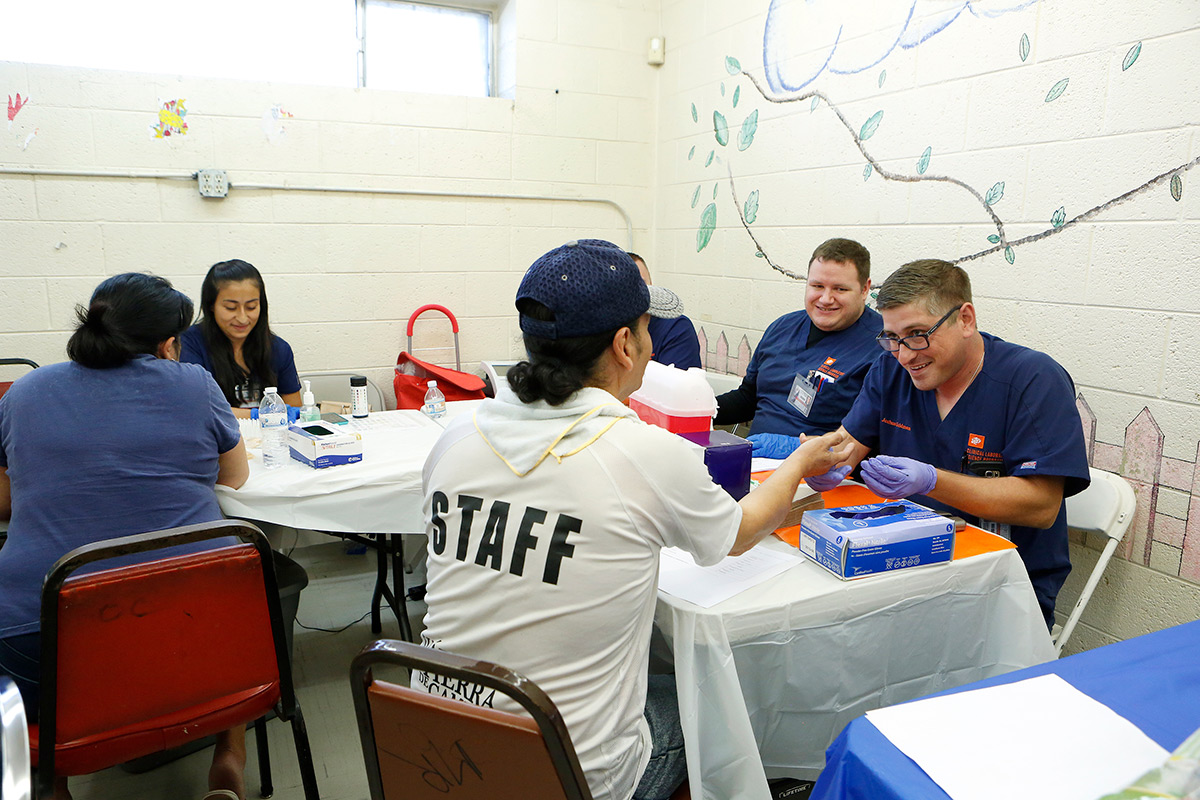UTEP’s Health Team Assists at H.O.P.E. Fair
Last Updated on October 16, 2017 at 12:00 AM
Originally published October 16, 2017
By Daniel Perez
UTEP Communications
Hundreds of El Pasoans converged Oct. 10, 2017, at the Opportunity Center for the Homeless for the fall H.O.P.E. clinics that were staffed by an interdisciplinary group of health care representatives from The University of Texas at El Paso.

Faculty, staff and students from UTEP’s College of Health Sciences and the schools of Nursing and Pharmacy worked together along with a cadre of community partners to make the free event a success for neighborhood residents, including those who live at the Opportunity Center, 1208 Myrtle Ave.
The HO.P.E. (Health, Opportunity, Prevention, Education) fair, which had a morning and afternoon session, involved vital tests, screenings and checkups, and the chance to learn about such important topics as diabetes, domestic violence, breast cancer and mental health. Some participants received referrals after their checkups to visit the on-site Centro San Vicente health clinic.
“This is awesome,” said Jeremy “Bubba” Howell, a H.O.P.E. regular. “This collaboration helps the homeless population and it helps the students in health and social work. Many times they do not understand how to work with (people who are homeless).”
The clinics serve several purposes. One goal is to provide health care to people in need. Another is to provide UTEP students from several health disciplines with a real-world experience where they can use what they have learned in the classroom, but also take themselves out of their comfort zone.
Eva Moya, Ph.D., interim chair and associate professor of social work, was as busy as anyone at the clinic. She is one of the main event organizers and helped start the clinics in April 2016. She called it a great way to serve the community and to train the students in their fields.
Among the representatives from the College of Health Sciences were students enrolled in the Master of Social Work (MSW) and Clinical Laboratory Science (CLS) programs. The MSW students helped register participants and directed them to the different test sites. In some cases, they escorted a few of the more frail patients to their screenings and checkups. Their CLS peers would prick fingers to draw blood and test it for such things as sugar levels, anemia and cholesterol. When necessary, the students would consult with the participant and suggest therapy or some form of rehabilitation counseling. Some patients were directed to a hearing clinic on the center’s third floor that was operated by the Paso del Norte Lions Club.
Among the first-time student volunteers were Claudia Huereca, a senior CLS major, and Laura Orozco, a MSW student. Both said whatever shyness or fears they had went away as soon as the clinic opened.
“I loved the direct contact,” said Huereca, who was a summer 2017 Minority Health and Health Disparities International Research Training (MHIRT) intern in Costa Rica. “I know many of these people have limited access to health care, so I tried to reassure them with a smile. I like making a difference.”
Orozco, who expects to graduate in 2019, helped open the clinic at 6 a.m. and admitted the temperatures were a bit chilly. The Lower Valley native said the cold temperatures did not keep the crowd away. She also praised the many volunteers, especially her UTEP peers, who worked together and exuded a warm, positive attitude.
For the morning clinic, she directed participants to where they could get their blood tested, and wrote referrals for clients. She mostly has worked with children in the past, so this was a new experience for her.
“I saw a different need today,” Orozco said. “This helped me grow.”
John Martin, the Opportunity Center’s development director, said the center’s officials, patrons and neighbors were grateful for the collaborative clinics that provided multiple benefits, including to the students.
“Now their studies are grounded in reality,” said Martin, who added that he hopes more UTEP students from other departments become part of future H.O.P.E. clinics. “We want students to experience working with people who live with homelessness. The two sides can learn from each other.”
Martin said the center’s clients and neighbors enjoy their interactions with the University crowd. The simplest acts of saying hello and sharing a smile brighten their day.
“These folks love to see new faces,” he said, pausing for effect. “They’re tired of seeing mine.”